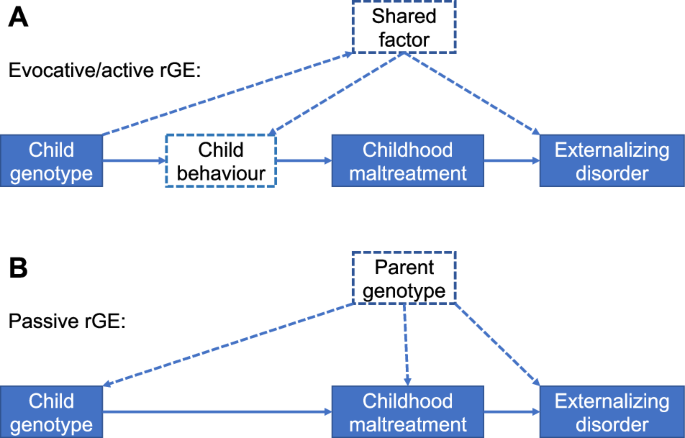Child maltreatment as a transdiagnostic risk factor for the externalizing dimension: a Mendelian randomization study
IF 10.1
1区 医学
Q1 BIOCHEMISTRY & MOLECULAR BIOLOGY
引用次数: 0
Abstract
Observational studies suggest that child maltreatment increases the risk of externalizing spectrum disorders such as attention deficit hyperactivity disorder (ADHD), conduct disorder (CD), antisocial personality disorder (ASPD), and substance use disorder (SUD). Yet, only few of such associations have been investigated by approaches that provide strong evidence for causation, such as Mendelian Randomization (MR). Establishing causal inference is essential given the growing recognition of gene-environment correlations, which can confound observational research in the context of childhood maltreatment. Evaluating causality between child maltreatment and the externalizing phenotypes, we used genome-wide association study (GWAS) summary data for child maltreatment (143,473 participants), ADHD (20,183 cases; 35,191 controls), CD (451 cases; 256,859 controls), ASPD (381 cases; 252,877 controls), alcohol use disorder (AUD; 13,422 cases; 244,533 controls), opioid use disorder (OUD; 775 cases; 255,921 controls), and cannabinoid use disorder (CUD; 14,080 cases; 343,726 controls). We also generated a latent variable ‘common externalizing factor’ (EXT) using genomic structural equation modeling. Genetically predicted childhood maltreatment was consistently associated with ADHD (odds ratio [OR], 10.09; 95%-CI, 4.76–21.40; P = 1.63 × 10−09), AUD (OR, 3.72; 95%-CI, 1.85–7.52; P = 2.42 × 10−04), and the EXT (OR, 2.64; 95%-CI, 1.52–4.60; P = 5.80 × 10−04) across the different analyses and pleiotropy-robust methods. A subsequent GWAS on childhood maltreatment and the externalizing dimension from Externalizing Consortium (EXT-CON) confirmed these results. Two of the top five genes with the strongest associations in EXT GWAS, CADM2 and SEMA6D, are also ranked among the top 10 in the EXT-CON. The present results confirm the existence of a common externalizing factor and an increasing vulnerability caused by child maltreatment, with crucial implications for prevention. However, the partly diverging results also indicate that specific influences impact individual phenotypes separately.


儿童虐待作为外化维度的跨诊断风险因素:孟德尔随机研究。
观察性研究表明,虐待儿童会增加患注意力缺陷多动障碍(ADHD)、品行障碍(CD)、反社会人格障碍(ASPD)和药物使用障碍(SUD)等外化谱系障碍的风险。然而,通过孟德尔随机法(Mendelian Randomization,MR)等能提供有力因果关系证据的方法对此类关联进行研究的却寥寥无几。鉴于人们日益认识到基因与环境之间的相关性,建立因果推论至关重要,因为这种相关性可能会对儿童虐待方面的观察研究造成混淆。为了评估儿童虐待与外化表型之间的因果关系,我们使用了全基因组关联研究(GWAS)的汇总数据,包括儿童虐待(143,473 名参与者)、ADHD(20,183 例;35,191 例对照)、CD(451 例;256,859 例对照)、ASPD(381 例;252,877 例对照)、酒精使用障碍(AUD;13,422 例;244,533 例对照)、阿片类药物使用障碍(OUD;775 例;255,921 例对照)和大麻类药物使用障碍(CUD;14,080 例;343,726 例对照)。我们还利用基因组结构方程模型生成了一个潜在变量 "共同外化因素"(EXT)。在不同的分析和pleiotropy-robust方法中,遗传预测的儿童虐待与ADHD(几率比[OR],10.09;95%-CI,4.76-21.40;P = 1.63 × 10-09)、AUD(OR,3.72;95%-CI,1.85-7.52;P = 2.42 × 10-04)和EXT(OR,2.64;95%-CI,1.52-4.60;P = 5.80 × 10-04)持续相关。随后进行的一项关于儿童虐待和外化联盟(EXT-CON)外化维度的基因组学分析证实了这些结果。EXT GWAS 中关联性最强的前五个基因中有两个,即 CADM2 和 SEMA6D,在 EXT-CON 中也名列前十。目前的研究结果证实,存在一种共同的外化因素,而且儿童受虐待后越来越容易受到伤害,这对预防工作具有重要意义。然而,部分不同的结果也表明,特定的影响因素会对个别表型产生不同的影响。
本文章由计算机程序翻译,如有差异,请以英文原文为准。
求助全文
约1分钟内获得全文
求助全文
来源期刊

Molecular Psychiatry
医学-精神病学
CiteScore
20.50
自引率
4.50%
发文量
459
审稿时长
4-8 weeks
期刊介绍:
Molecular Psychiatry focuses on publishing research that aims to uncover the biological mechanisms behind psychiatric disorders and their treatment. The journal emphasizes studies that bridge pre-clinical and clinical research, covering cellular, molecular, integrative, clinical, imaging, and psychopharmacology levels.
 求助内容:
求助内容: 应助结果提醒方式:
应助结果提醒方式:


